|
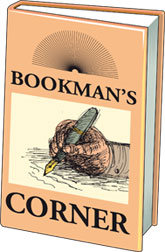
Facts and figures now at your fingertips
Reviewed by U.D. Dharmabandu
It is no secret that the country lacks and desperately needs a
series, if not an omnibus volume, of comprehensive ready reference books
detailing succinctly facts and figures on various disciplines inclusive
of the island’s culture, history, people, religions and beliefs, norms
and values and tracts of other relevant and allied information for the
benefit of the inquisitive students, policy makers or broadly any
researchers worth of his salt.
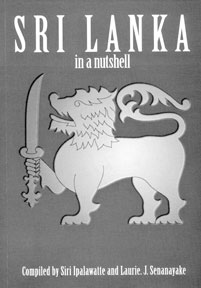
SRI LANKA in a nutshell
Authors; Siri Ipalawatte and Laurie J. Senanayake
Published by Sarasavi Publishers
|
Arguably, Sri Lanka though a small developing country can boast of
many books and tomes written and published on almost all areas of
disciplines, knowledge or interest.
But a single ready reference book that provides access to facts and
figures or any other desired information on any of the board disciplines
has been a long felt need in Sri Lanka.
Caught up as we are in the vortex of a maddeningly fast moving world
nobody can afford long hours poring over books and other sources to get
at a particular fact or piece of information. Suppose someone wanted to
know which king ruled in Sri Lanka when, or the details of ancient tanks
our great kings built or parochially which two reservoirs were joined to
form one single tank, or area of forests under the Forest Department or
more mundanely the number of Sri Lankan households using e-mail and the
internet is there a single source book for him to turn to? No, Sir. Not
in Sri Lanka!.
In what appears to be a laudable and trailblazing initiative to fill
lacuna Siri Ipalawatte and Laurie J Senanayake, both Sri Lankan
expatriates, have just brought out Sri Lanka in a nutshell’.
This is the climax of a year-long mission they have embarked upon on
a conscientious urge to give back something to the country that nurtured
them.
Ipalawatte, a former lecturer at the University of Kelaniya and
holder of Master of Science degree in Economics from the University of
Wales UK had worked in the Australian Bureau of Statistics, Canberra for
20 years. Before that he had worked as a statistician in the Department
of Census and Statistics back home.
His co-compiler Laurie J Senanayake, holding a degree of Master of
Information Technology from the University of Canberra, Australia had
worked as a computer programmer at the same Australian Bureau of
Statistics, Canberra.
Drawing upon their rich professional experience as statisticians and
culling information and facts from various sources such as books,
reports, published and unpublished documents, the internet they have
painstakingly prepared this book in a ‘no frills’, easy to grasp, simple
language format.
This publication, needles to say, inadvertently serves another useful
purpose. It is no secret that a sizable portion of our younger
generation is out sync and rapport with the rich culture and history of
the country due mainly to the wrong and inappropriate educational
policies in the not too distant past.
On top of the having been handicapped in a 30-year old terrorist
problem which many believed unwindable the people had lost all sense of
perspective and belonging of the country and its greatness and were
existing on a day to day basis being uncertain what the future will be.
So when the ugly strife was finally contained a year back the people
awakening like the proverbial Rip Van Winkle are beginning to remember
and identify themselves with their country and rich heritage.
Thus at a time when the country is at a crossroads our younger
generation inclusive of our legislators (a vast and unprecedented number
of young blood has entered Parliament this time) should be made
conscious and knowledgeable of the strengths and weakness of the
country.
Then only they will get motivated to make a meaningful contribution
in their own individual level that will accrue to the greater good of
the country.
That motivational role will definitely be played by any book that
tries to present a comprehensive picture of a nation’s greatness and
resilience through facts and figures. The book under review seems
replete with such characteristics.
The compilers who expect no profits or any other advantages from this
exercise have already made available copies to the country’s top
decision makers.
And they have already started discussions with the state and
provincial authorities to make some hundreds of copies of the book
available for distribution to school libraries.
Interestingly, a person who happens to lay his or her hands on a copy
of this book could regale himself or herself improvising quizzes out of
the vast nuggets of information and facts it contains for the
edification of oneself or others.
“Do you know who built Kala Wewa?” one could ask a friend for
instance.
“Of course King Dhatusena, stupid,” a smart Alec could very well
respond.
“Well, can you name the two tanks joined by King Dhatusena to make
the mighty Kala Wewa?”
Chances are that even a supposedly Know All would be momentarily
stumped or simply not be able to recall the names of the two tanks.
One needs only look under the heading ‘ancient irrigation’ to glean
the quaint information Kala and Balalu, the two reservoirs built earlier
that were joined to create Kala Wewa.
By the way, how many of us know or care to remember that it was the
same great Dhatusena who built the amazing 87 km-long canal, the
Jayaganga with a gradient of six inches to a kilometre on the first 27
kilometres of its course to facilitate the flow of water from Kala Wewa
to Tisa Wewa.
All such facts and snippets are there to arouse the interest of the
reader besides enriching his or her knowledge about the country.
The experience of the compilers as professional statisticians is
reflected in the various forms of statistics presented by them in easy
to grasp form. The statistics on distribution of population, 139 years
of population growth from 1871 to 2008, population by region, ethnicity
or population and density by province etc may prove immensely useful to
our legislators, policy makers and researchers.
Apart from that the short monographs on the share market, transport
and communication, radio, Television, films and other media among others
are refreshing and informative. However, a glaring omission was observed
in the column ‘Newspapers currently published in Sri Lanka’, the
flagship Sinhala daily, Dinamina, has been dropped from the list.
Equally disturbing omission is the composer of our national anthem,
singer and musician, the late Ananda Samarakoon who did a monumental
service for the cause of the Sinhala music with a plethora of such
vintage favourites as “Siri saru sara kethe goyam paseela mahime”, “Besa
seethala gangule peena peena namuko nago” etc his eternal credit being
left out of the list of ‘popular singers of Sri Lanka’!
Admittedly, such omissions are bound to occur when making a book like
this for the first time no beacons to guide their movements on
unchartered water. But now that a start has been made they can build on
the structure hopefully with the expected feedback from readers and
well-wishers and bring out a more comprehensive and accurate edition
next time.
By the way, the index at the tail end of a book very much in vogue in
days gone by seems to have gone extinct in modern day book publishing at
least in Sri Lanka. The value of this book would have risen manyfold if
a comprehensive index has been incorporated into it.
Needless to say, the index arranged as it is alphabetically
indicating where in the book reference to a particular person or subject
could help the reader to locate a fact or piece of information quicker.
Of course, preparing a comprehensive index is a very tedious, costly
and time-consuming exercise but worth its value in gold.
Those accidental and unintentional omissions apart another positive
aspect of the book is its usefulness to foreigners who take an interest
in our country. And those foreigners who care to visit Sri Lanka as
tourists would also find this publication useful to guide their liking
and to educate themselves of the various aspects of the island.
That apart those who aspire to sit for public examinations for
recruitment to various state services including that of Sri Lanka
Administrative Service may find this book useful as it enriches their
general knowledge.
The beauty of this book is that anybody who happens to be even idly
turning its pages may stand to gain some knowledge about Sri Lanka.
The compilers, true to their pro bono publico (for the public good)
spirit welcome a feedback from the readers.
The riddle of the cuckoo
by K. G. H. Munidasa
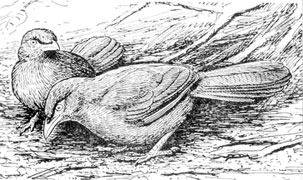
Ceylon Common Babbler

The young English Cuckoo ejecting the egg from the nest of its
foster parents |
A nature lover in my neighbourhood, who has a keen eye for birds, has
witnessed a sight that no other bird-watcher, for that matter any
ornithologist has ever seen. He has observed a Pied Crested-Cuckoo (a
true cuckoo) feeding a young of its fosterer. The Ceylon Common Babbler. nature lover in my neighbourhood, who has a keen eye for birds, has
witnessed a sight that no other bird-watcher, for that matter any
ornithologist has ever seen. He has observed a Pied Crested-Cuckoo (a
true cuckoo) feeding a young of its fosterer. The Ceylon Common Babbler.
On a previous week during a ramble in the tree-studded scrub on the
outskirts of the village, some movement in a tree drew his attention.
When he walked up to investigate he found two birds sitting side-by-side
on a branch there, ten-feet from the ground. One was a Pied-Crested
Cuckoo and the other an immature Common Babbler.
The babbler with its gape wide open was demanding food from the
cuckoo, which promptly stretched out its neck and placed some morsel in
the young one’s mouth. This was instantaneous and short-lived, for on
seeing the intruder the cuckoo fled into the jungle, followed by the
babbler.
After relating the story to me, the nature lover posed the inevitable
question - could such a thing ever happen? With all my personal
knowledge of the breeding biology of this resident cuckoo and what I
subsequently gleaned from published accounts on the subject of “Cuckoo
Problem” that I could lay my hands on, I am still unable to find a
satisfactory solution to the riddle.
Being fed
Once in the Gal Oya valley, years ago, I found a young of this cuckoo
being fed by a party of the Ceylon Common Babbler, in a srubland beside
the public road. There were five babblers in the party, whilst two of
them attended on the baby cuckoo the rest foraged in the carpet of dead
leaves, beneath a hedgerow. It was the young bird’s hunger note that
prompted me to look around, but I never expected to find a cuckoo. Its
cry was strongly reminiscent of a young babbler.
Demanding food from the foster parents it imitated a young babbler
extremely well, but in all outward appearance it hardly resembled one,
apart from its size and colouration. It was sooty-black above and
buff-white below, except the chin and breast, which were greyish. The
beak was horny-yellow as in a babbler. More than anything else the white
wing-patches gave away its correct identity.
Throughout its range, mainly in the Low-Country Dry Zone, the
Pied-Crested Cuckoo is known to victimise the Ceylon Common Babbler or
“Seven Sisters” in whose nest it lays its eggs. The newly hatched
cuckoos are cared for by the babblers until such time they are able to
fend for themselves. All true cuckoos in their breeding habits never
look into the needs of the young, since they are looked after all along
by the selected foster parents.
Difference
Yet, in the present instance couldn’t it have been possible that the
cuckoo found its fosterer’s baby while the parents were away foraging
for food?
Or, on the other hand, one might like to ask, could cuckoos have been
solicitous towards its own young after the foster parents had deserted
it?
Whatever it may be, the second theory is not up to the facts.
Because, there seems a vast difference between the two species involved
and further, my informant was positive what he saw was a Common Babbler,
a common garden bird in any area.
The young cuckoo’s stratagem for survival is a wonderful exhibition
of ingenuity and resorucefulness in nature. When it is first hatched
from an egg the young cuckoo is harmless-looking little lump of flesh.
But, nonetheless it is gifted with an amazing physical prowess and
matured instinct for an innocent chick.
Ejecting procedure
On the second or the third day, although blind, it begins to take
stock of the situation inside the nest. If there are other eggs or
nestlings there it knows by instinct there would be future rivalry for
food. Therefore, it proceeds to oust the other occupants of the nest,
forthwith.
A British ornithologist who once watched a young of the English
cuckoo ejecting a young Sedge-Warbler, twice its own size, from the nest
has recorded thus, “The cuckoo showed the most amazing powers of
strength. It worked down in the nest until its companion was on its (Chckoo’s)
back, then gripping the sides of the nest with its feet it slowly and
surely raised its burden.
When it appeared to have reached the extent of its stretching powers
it opened the small flesh arms (unfledged - wings) and began to work
these up and down.
It also jerked its body upwards with violent movements with the
result that the young warbler was flung ignominiously over the side of
the nest.”
Usually the young cuckoo grows up fast since it monopolises the
attention of the foster parents. Once it is able to fly they follow it
about attending to the further needs of the young cuckoo. Here not only
the foster parents, but also other birds in the neighbourhood who are
with their own broods sympathise with the young cuckoo and offer the
food they would be carrying for their own young.
Even otherwise, if they ever come across a baby cuckoo crying all
alone in a branch they would go out of the way to bring mouthfuls of
food to appease its voracious appetite. There is a record of a young
cuckoo brought up by a pair of Hedge-Sparrows having been fed in turn by
five different species of birds.
New on the shelf
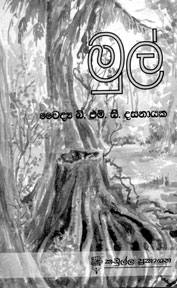
Title: Mul
Author: Dr. B.M.C. Dassanayake
Kadulla publishers
The latest edition of ‘Mul’ is now available in leading book shops.
[Book launch]
Budu Dahamai Maha Muhudai Kelanitissa Rajjuruvoi
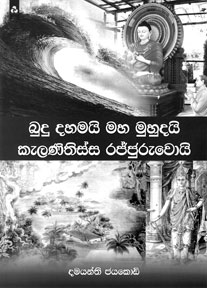
The latest edition of Damayanthi Jayakody’s Budu Dahamai Maha Muhudai
Kelanitissa Rajjuruvoi will be launched at Dayawansa Jayakody Book
Exhibition Hall, Ven S. Mahinda Mawatha, Colombo 10 on June 22 at 10.
a.m.
Mrs. Jayakody is the author of several other books including Ape Budu
Hamuduruwo, The Jewel of the Universe, Ape Jathika Kodiye Sinha Nadaya,
Uthum Thunuruvana Ape Ekama Pihitai, Deviyo Ehi Vediyaha, Ape Bosathanan
Vahanse, Ashcharyavathmai Adbhuthamai! Gauthama Buddha Charithaya I
Bosathanan Vahanse, and Nalakaraya.
“Budu Dahamai Maha Muhudai Kelanitissa Rajjuruvoi is a Dayawansa
Jayakody publication. |

